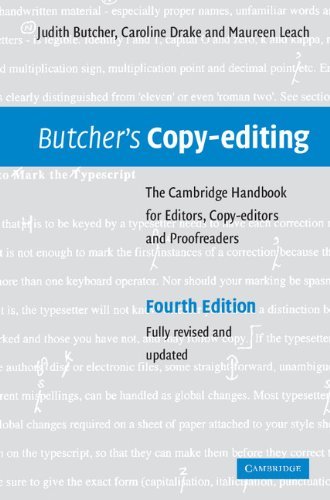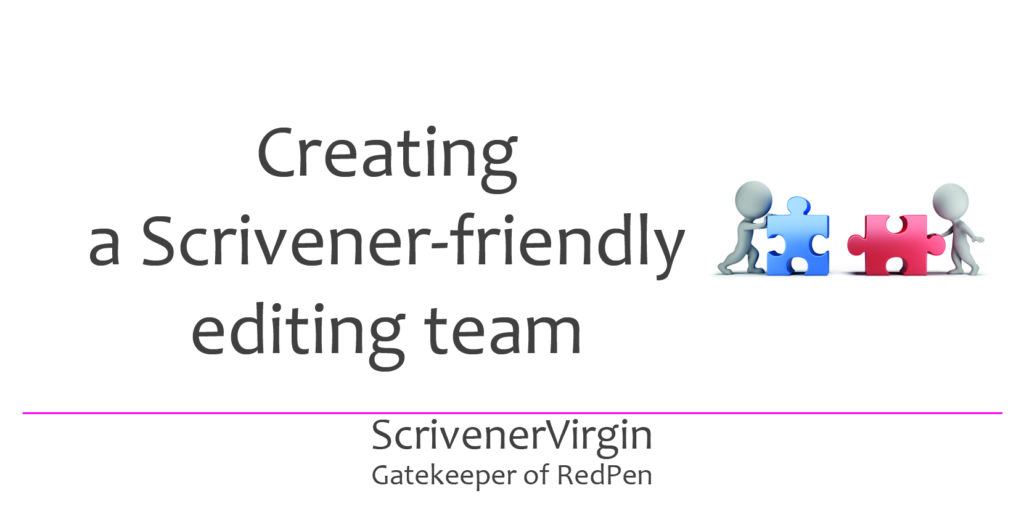
Creating a Scrivener-friendly editing team
Choose an editor who uses Scrivener
If you plan to self-publish, deciding to use Scrivener is step one: software that will take you from blank page to published book. Well done!
Once you’ve self-edited your first draft, the next step is to set up your editing team, publishing professionals who also use Scrivener …
Your editing team
There are three types of editor:
- Developmental
- Copy
- Line
For financial reasons, you might want to complete as much of the editing as you possibly can, and thus minimise the amount of external support needed. However, don’t make the mistake of going to print without some professional editing input.
What does a developmental editor do?
A developmental editor reads the first draft of your manuscript – or maybe only some of it, plus your outline – and advises on ‘big picture’ issues.
He/she should tell you what is working well, but also draw attention to aspects that require attention.
- CONTENT/STRUCTURE/SEQUENCE
Is it all there? Is it in the best order?
For non-fiction:
Have you scoped out the content to create a useful product?
Have you included appropriate features and resources?
For novels:
Are there any plot holes? Do you need to write more scenes?
Are there weak spots in the narrative?
How’s the timeline? Do chapters need moving around? Do scenes within the chapters need reordering?
How’s the pace? Too fast? Too slow? - STYLE/LANGUAGE
Are there inconsistencies in style or tone?
Are there any major concerns about spelling, punctuation or grammar which indicate you need extra help in fixing the text.
For non-fiction:
Is the language understandable to the intended audience? Is it jargon heavy?
For novels:
Is there an appropriate balance between narrative and dialogue?
Is it too wordy? Is there an excess eg of adjectives or adverbs?
Is the passive voice overused?
Is there too much ‘tell’ and not enough ‘show’? Or vice versa?
Does your voice/tone suit the intended audience? - CHARACTERS/SETTINGS (in a novel)
Do they ‘work’? Are there too many?
Are the characters’ voices consistent?
How well are the characters/settings developed? Well enough?
Can characters/settings be differentiated easily by the reader? - IMAGES/ILLUSTRATIONS
Do they enhance the text? Are they essential? Are more needed?
What a developmental doesn’t do is to fix typos and punctuation errors. For that level of editing, you need to have produced a final draft of your manuscript and employ a different type of editor.
What does a copy editor do?
A copy-editor reads the entire manuscript. The assumption will be that your book is complete. All the items on the developmental editing list have already been ticked! (However, a good copy editor – or, indeed, a good proofreader – will draw your attention to any such outstanding issues.)
The copy editor addresses mostly ‘style issues’.
- What is your style? Is it consistent?
- How does the material/story come across to the reader?
- Is the pace ‘right’ for the genre?
If there are spelling errors, a good copy editor will fix them on the way past but, if there are too many, their time budget may not allow for a heavy edit of your material. Best to fix them yourself before approaching a copy editor.

And, so as to not waste any of the copy editor’s time, you should provide them with your style sheet.
What is style sheet?
A style sheet records all ‘style’ decisions you’ve made. This includes those regarding spellings (eg -ise versus -ize), accents, hyphenation, capitalisation (eg Mother or mother), quotes (single versus double), use of italics/bold, abbreviations and contractions, how you will express numbers and dates, and how you will cross-refer (eg see p.14 or see page 14).
The purpose is to provide an editor with a guide as to how the text has been written and presented. The aim is for consistency of style, so the editor needs to know what you intended. While you are writing, it’s also a useful reminder to yourself about the style decisions you’ve made.
For more information on style sheets, and the role of the copy editor, refer to Judith Butcher’s Copy-Editing. Reading this classic reference book could also make you a better editor …
What does a line editor do?
Your copy editor may well have fixed much of this, but a line editor concentrates on the accuracy of language and grammar, including punctuation.
Line editors might also format your text for you, if that’s something which troubles you – or you might need to employ a separate formatter too.
How many do you need in your editing team?
You don’t need to employ separate editors for each task; one editor might suffice. The important qualification will be their ability and willingness to work with you, in Scrivener, so you retain the option to self-publish using Scrivener.
If an editor insists on working in Word (because they claim it is the ‘industry standard’), processing their feedback is twice as time-consuming than if they are willing to work in Scrivener.
And, what about proofreaders?
There are proofreaders who will just read the entire manuscript looking for typos, ie spelling mistakes. You might find beta readers willing to read for you, in exchange for nothing more than an early copy of your book.
Sending your manuscript to your editing team
So, provided you can find an editor (developmental / copy / line) who also works in Scrivener, you simply send your project file to him/her and ask for all feedback to be provided within that project file. The file size is large; I recommend my authors use WeTransfer, a free online service.
While the editor is processing your project, you will need to work on something else until the material is returned to you. This enforced break can be put to good use.
- Reconnect with family and friends
- Take a holiday!
- Work on something else altogether
- Think about your marketing
For proofreaders and beta readers, it’s important to provide an experience that is as close to reading the book in its final form as possible.
- If you are producing a paperback, output to PDF as an interim form.
- If you are creating a Kindle or ebook, output to eBook.
What material does the editor need?
The developmental editor is usually approached once you have a first draft, suitably tidied, ready to be shared.
- For a non-fiction book, this could be the entire manuscript, plus maybe supporting material which shows what research has been done to uncover the information in the book. However, you might approach a developmental editor even earlier, with just an outline of what you intend to produce.
- For a novel, I’d recommend you complete a synopsis for every scene, and a synopsis for every chapter. You should also have character sketches for all the main characters, and setting sketches too, with images as appropriate. Ideally, the first draft will also be complete.
You could also include, in your Scrivener file, notes for the editor, listing any particular issues that are worrying you that you would like to be addressed during the developmental edit.
Where can you find an editor?
There are lots of sources.
- The Society for Editors and Proofreaders (SfEP) maintains a directory of their members which you can search and/or place an advertisement specifying what you need.
- Reedsy is one of many organisations bringing together publishing professionals, and writers. You need to create an account, but otherwise the service is free to authors.
- Professional organisations such as The Alliance of Independent Authors maintain a self-publishing services directory, available to its subscription members.
In the next post, I explain how the editor might communicate with an author, in Scrivener, leaving messages for the author to action. In a subsequent post, I explain how the author would process these communications.
If you are an editor, using Scrivener, and would like a guest post on this blog, email me at an**@*************in.com. I’m happy to promote editors who are willing to support authors who want to write, edit and publish using Scrivener.
Any questions? Need a helping hand?
To watch me writing/editing using Scrivener or to ask any questions, book a Simply Scrivener Special.
To help me to prepare for the webinar, please also complete this short questionnaire.
The ScrivenerVirgin blog is a journey of discovery:
a step-by-step exploration of how Scrivener can change how a writer writes.
To subscribe to this blog, click here.
You can also find links to blogs of specific topics in the Scrivener index.
Also … check out the Scrivener Tips.



No Comments